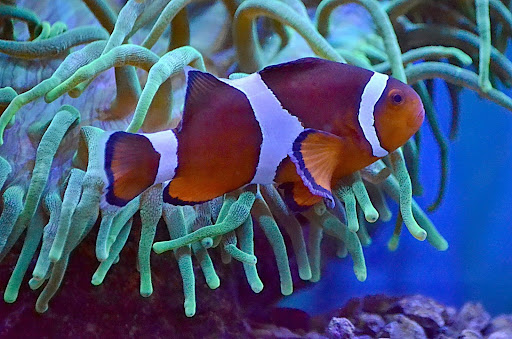
Clownfish, scientifically known as Amphiprioninae, are small yet vibrant fish that belong to the family Pomacentridae. Renowned for their striking colors and distinctive relationship with sea anemones, clownfish are one of the most popular species in the marine world. Found in the warm, tropical waters of the Pacific and Indian Oceans, these fish have captured the fascination of marine biologists and aquarium enthusiasts alike. This article will delve into the various aspects of clownfish, including their behavior, habitat, diet, reproduction, and their symbiotic relationship with sea anemones.
1. Physical Characteristics of Clownfish
Clownfish are easily recognizable due to their bright orange bodies, accented with white bands outlined by black borders. Their dorsal fin is typically triangular, and they have small, rounded tails. These fish grow to an average size of 3 to 4 inches, although some species can reach up to 6 inches. The most common and well-known species of clownfish is the Amphiprion ocellaris, often referred to as the “false clownfish” or “common clownfish.” Their vibrant colors are not just for show—they also serve as a warning to potential predators about their toxic symbiotic relationship with sea anemones.
2. Habitat and Distribution
Clownfish are primarily found in the warm, shallow waters of the Pacific and Indian Oceans, typically in coral reefs and lagoons. They are commonly associated with the Indo-Pacific region, particularly around areas like the Great Barrier Reef, the Philippines, and parts of Southeast Asia. Clownfish thrive in water temperatures ranging from 73°F to 82°F (23°C to 28°C), where they can find an abundant supply of food and shelter.
These fish are often seen in the vicinity of sea anemones, as they share a unique and beneficial relationship with these creatures. Sea anemones provide a safe refuge for clownfish, while clownfish offer food in the form of parasites and detritus that accumulate around the sea anemones.
3. The Symbiotic Relationship with Sea Anemones
One of the most remarkable features of clownfish is their mutualistic relationship with sea anemones. This relationship is one of the most well-studied examples of symbiosis in marine biology. Sea anemones have venomous tentacles that can paralyze and kill other fish. However, clownfish are immune to the sting of these tentacles due to a special mucus coating on their skin. This adaptation allows them to live among the sea anemone’s tentacles without being harmed.
In return for the protection provided by the sea anemone, clownfish offer a variety of services. They help clean the anemones by eating parasites and small invertebrates. Furthermore, clownfish often act as “bodyguards” for sea anemones, chasing away potential predators. This mutualistic bond is beneficial for both species and highlights the fascinating nature of clownfish behavior.
FOR MORE INFORMATION CLICK HERE : new restaurants in dubai
4. Behavior and Social Structure
Clownfish exhibit interesting behavioral patterns, especially when it comes to their social structure. These fish live in small, tightly-knit groups, with a clear dominance hierarchy. The group typically consists of a breeding pair, along with smaller, non-breeding males. The largest fish in the group is the dominant female, and she is the only one that mates with the dominant male. If the female dies, the largest male will undergo a sex change to become the new female. This unique reproductive strategy helps ensure the continuation of the group.
Clownfish are highly territorial, often defending their sea anemone home from other fish species. Their aggressive behavior is particularly evident when they are protecting their nests or when competing for space in an anemone. Despite their feisty nature, clownfish are social creatures that often engage in playful interactions with other members of their group.
5. Diet of Clownfish
Clownfish are omnivorous, feeding on a wide range of food sources in their environment. Their diet consists mainly of zooplankton, algae, and small invertebrates. They are also known to nibble on the detritus that accumulates in the sea anemone, such as leftover food scraps. The availability of these food sources around their host anemone ensures that clownfish do not have to venture far from their shelter.
In addition to natural sources of food, clownfish are often fed by aquarium owners who keep them as pets. In these settings, they are typically given a diet of flakes, pellets, and frozen foods designed for marine fish. Proper nutrition is vital for clownfish, as it helps maintain their bright coloration and overall health.
6. Reproduction and Lifespan
Clownfish reproduce by laying eggs, which are usually deposited on a flat surface near their sea anemone home. The breeding pair works together to guard and protect the eggs from predators. Male clownfish are responsible for maintaining the eggs, keeping them clean, and aerating them by fanning water over them with their fins. The eggs typically hatch in about 6 to 10 days, and the baby clownfish, called “fry,” are released into the water.
The fry rely on the sea anemones for protection and food in the early stages of their life. Clownfish generally have a lifespan of around 6 to 10 years, depending on their environment and the presence of predators. In the wild, their lifespan may be shorter due to the various threats they face, but in captivity, they can live longer with proper care.
7. Clownfish in the Aquarium Trade
Clownfish have become a staple of the aquarium trade due to their striking appearance, manageable size, and unique behaviors. They are often seen in home aquariums, where they thrive in well-maintained saltwater environments with live rock and a suitable host anemone. Due to their popularity, various species of clownfish, such as the Amphiprion ocellaris and Amphiprion percula, are bred in captivity and sold to aquarium enthusiasts.
However, keeping clownfish in an aquarium requires a commitment to maintaining water quality and providing a suitable habitat. It is essential to replicate the conditions found in the wild, including stable water temperatures, salinity, and the presence of a compatible sea anemone or other hiding spaces. With proper care, clownfish can live comfortably in an aquarium for many years.
Conclusion
Clownfish are fascinating creatures with a unique set of characteristics that set them apart from many other marine species. Their vibrant colors, symbiotic relationship with sea anemones, and interesting social behavior make them a subject of admiration and study in the marine world. Whether in the wild or in aquariums, clownfish continue to captivate the imagination of people around the world. By understanding their natural behaviors, habitat needs, and ecological significance, we can ensure that these remarkable fish continue to thrive for generations to come.


